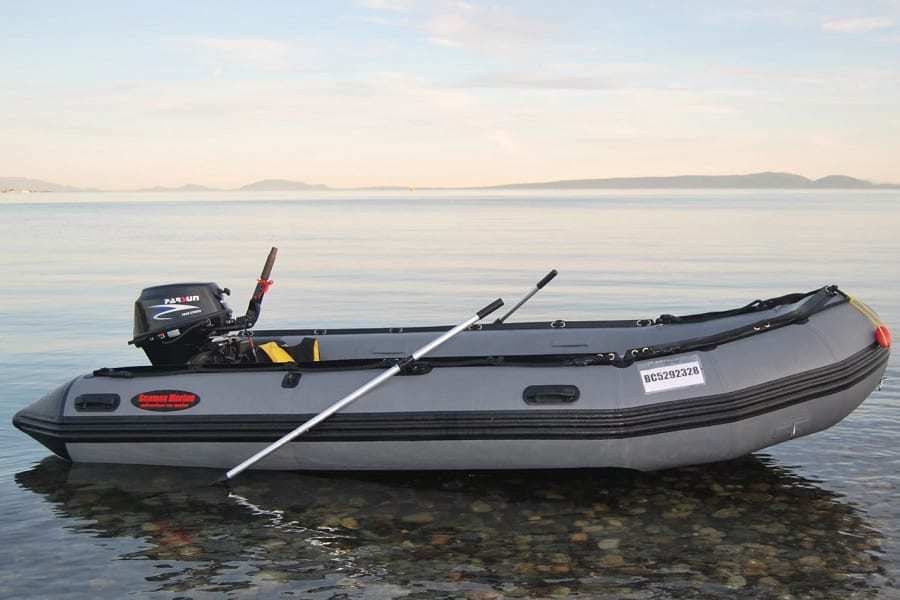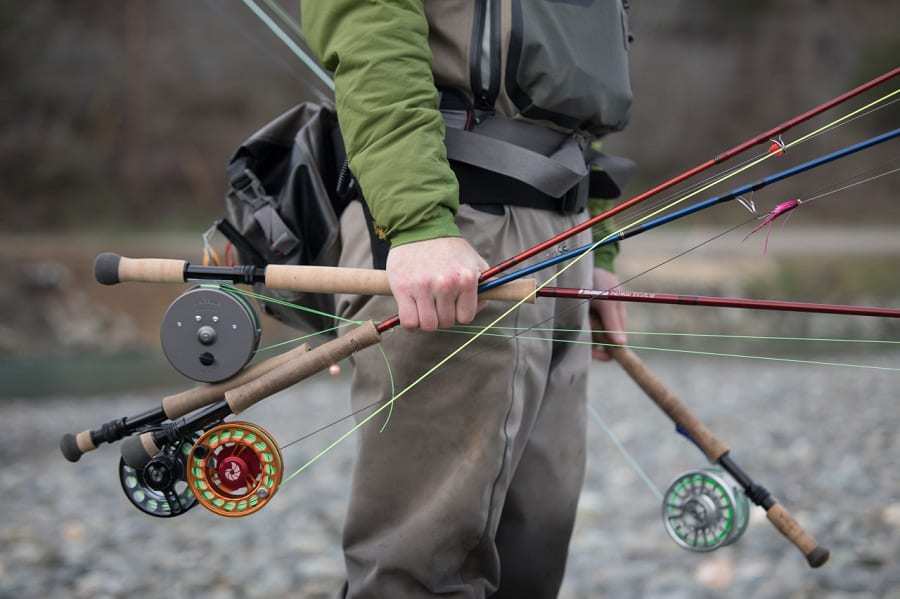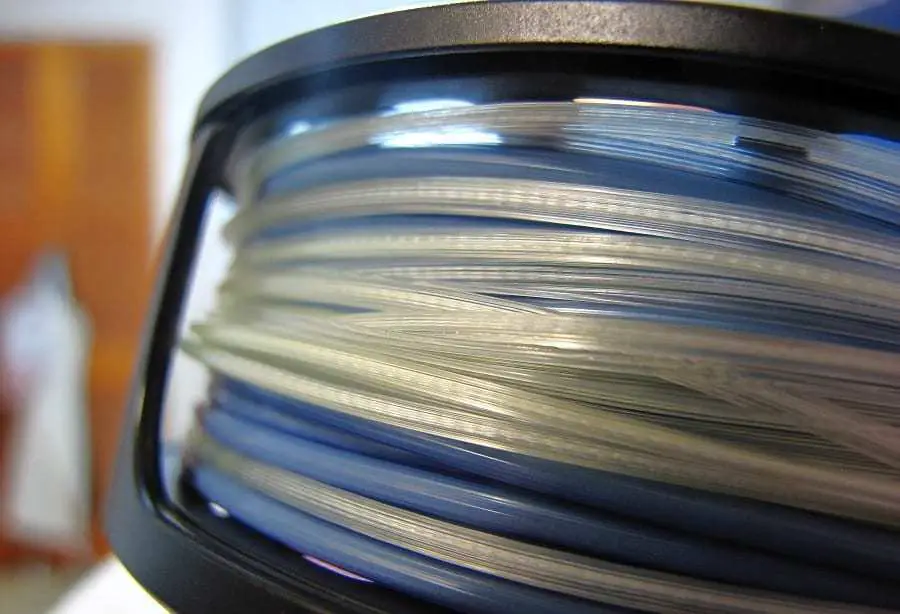Whether you are considering the best whitewater fishing rafts or maybe a comfortable inflatable kayak, we want to help you get into an inflatable watercraft that you can enjoy for years to come.
Best Inflatable Boats By Type
You are probably familiar with most of the common designs when it comes to inflatable boats.
But the number of inflatable boat designs are so incredibly diverse that there is just no way we could possibly cover them all here, and we aren’t exaggerating.
RIGID INFLATABLE BOATS

If you are considering an inflatable boat for ocean use, then a rigid inflatable boat is what you will need.
Ocean swells and currents can be serious and many times a set of oars won’t do the job. This is where a rigid inflatable raft provides real advantages.
The best rigid inflatable boats for rough waters provide a solid transom for motor mounting. Fighting the ocean current is no joke and the benefits of a strong motor can help you get to your destination safely.
Another important feature is the need for a rigid ‘V-shaped hull. Inflatable boats without this feature will be less stable, slower in the water, and won’t provide for easy planing, which means the inflatable boat won’t rise up and glide on top of the water.
The best inflatable boats for ocean use will also have a USCG rating, meaning that the vessel meets or exceeds US Coast Guard specifications for safety and design.
Depending on their size, most rigid inflatable boats can host a small group of passengers.
INFLATABLE KAYAKS

One of the many benefits of inflatable kayaks is the fact that they are primarily fabric, and can be packed into fairly small spaces for easier transport and storage.
Like conventional kayaks, inflatable kayaks are also easy to paddle through the water at quite the brisk pace.
Since they are so nimble and quick on the water, it is tempting to consider folding them into a large hiking pack for a backwoods adventure. But it is worth noting that most inflatable kayaks weigh-in around 40+ pounds.
That might not sound too heavy, but it can feel like 100 pounds if you over-extend yourself on a long hike.
Inflatable kayaks typically have a wide and stable design, so they can avoid being easily overturned. But if you want to be able to stand up to cast when fishing, then you’ll need to look for the widest inflatable kayak you can find.
Having a good sense of balance never hurts either.
Fishing kayaks are going to differ slightly from kayaks made for regular recreational use. Many are designed to be stable enough for some standing, depending on your balance.
Kayaks with a narrow width make standing quite risky, as any small wave could test just how good your balance is. And inflatable kayaks for fishing will also offer features specifically for fishing.
These boats are particularly ideal for anglers who need a maneuverable inflatable boat that can move fast when needed, like in fast moving water.
Good quality inflatable kayaks will have scupper holes as well. These drainage holes which allow water from paddling or rain to drain out through the bottom of the boat.
A tracking fin is a must as well. Otherwise paddling will have you zigg-zagging across the water. Advanced Elements and NRS both have models specifically designed for fishing.
WHY WE DON’T RECOMMEND SIT-ON-TOP INFLATABLE KAYAKS
Sit-on-top kayaks usually have high center of gravity that can increase the risk of accidentally capsizing.
Sit on top kayaks are wonderful boats for recreation boating when you don’t mind getting a little wet – or maybe even want to.
But they won’t compare with the stability of inflatable fishing kayaks which are often loaded with features that tournament anglers and hardcore anglers will appreciate.
Sit inside inflatable kayaks are very similar to a frameless pontoon boat, which we cover below. They often have an inflatable or rigid floor board that is conducive to standing, and the low center of gravity also adds to the overall stability.
Open floor space provides ample space for gear-heavy trips. The seat is in a fixed position facing forward, so swiveling to cast in different positions won’t be an option.
Depending on the design, the floor of an inflatable kayak might accumulate water. But our favorite designs are those with self-bailing floors or scuppers that quickly drain water away.
STORAGE BENEFITS
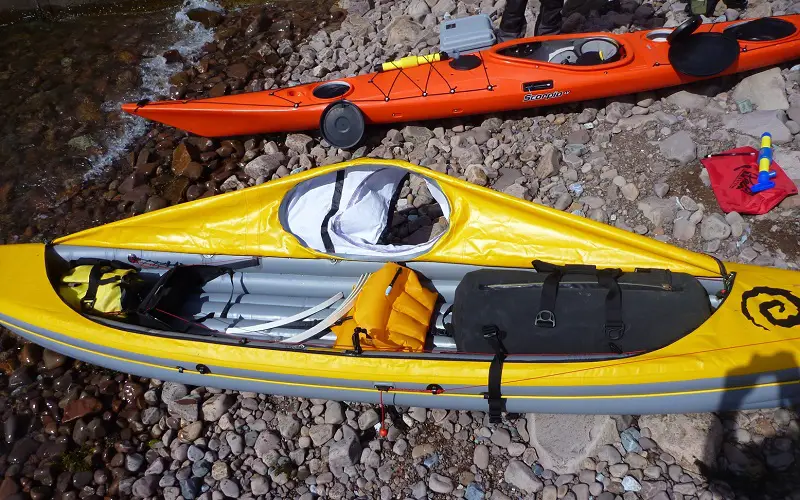
This is one tremendous advantage inflatable kayaks offer over conventional kayaks. Since inflatable kayaks have few rigid parts and framework they store away in small spaces with ease.
For those living in apartments or homes that do not have extra storage space to spare, these boats pack away conveniently and can be stashed out of the way.
And if you live in an area where you have concerns that a boat stored outdoors might be stolen, inflatable kayaks provide for storing securely indoors behind lock and key.
Inflatable kayaks come in all price ranges, but beware, most bargain models will not resist puncture. Fishing hooks and cheap vinyl are not a good combination.
These cheap inflatable kayaks won’t have rod holders for the fishing enthusiast either. More often than not, cheap inflatable kayaks also have pinch valves reminiscent of pool toys, rather than spring and boston valves.
In the end, it is worth it to spend a little coin on a quality inflatable kayak.
INFLATABLE PONTOON BOATS
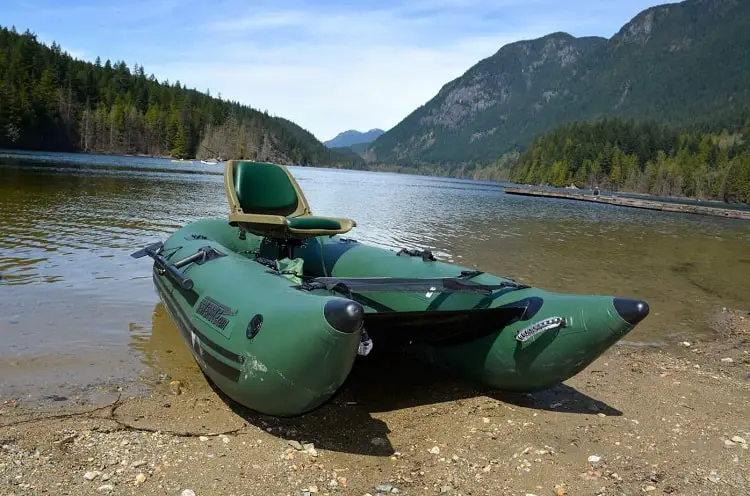
You might ask, what differentiates inflatable pontoon boats from other inflatable boats? Well honestly, the dividing line is pretty hazy.
In the end how a manufacturer refers to their boat is less important than finding the features you want to have for an enjoyable experience. Take a look at our top pontoon boat choices for more information on their varieties and features
Generally speaking, an inflatable pontoon boat is going to offer you a lot of capability in moving water. For drift style fishing in a river, or even light whitewater conditions, a pontoon boat can be fantastic.
Pontoon boats are stable due to their separated pontoons which creat a large flat platform with a low center of gravity. Most have oars and oar locks, raised seating, and possibly a motor mount when you want to really get on the move.
FRAMED PONTOON BOATS
Framed pontoon boats are very popular and for good reason. They are a clear step up from inflatable boats like float tubes. But carrying a boat of this size for miles into the backcountry simply is not practical.
Comfort and functionality is the primary focus of inflatable pontoon boats, while sacrificing some ease of portability.
Anglers sometimes use pontoon boats for moving rivers, and light even light rapids, but you we don’t recommend attempting this with lesser quality inflatable pontoon boats. Always follow manufacturer recommendations and purchase reliable, quality inflatable boat.
Pontoon boats provide a great deal of comfort and they also can keep an angler entirely out of the water. The pontoons sit the angler high, while still keeping the water within reach if an angler want to use fins.
Gear can be stored in pockets and bags that are attached to the pontoons, or in a gear rack behind the seat.
Seating in a pontoon boat also provides rigid support for those with back pain. And anglers with knee pain will really love the option of using oars.
The ability to row a pontoon boat makes covering water easier, and moving water becomes easier to handle as well. Inflatable pontoon boats don’t usually come equipped with tracking fins, so they tend to drift in windy conditions.
But this is will play to your benefit in moving water where a lack of tracking fins will enhance maneuverability.
Though framed pontoon boats are fairly substantial, most small to mid-sized models are not designed to carry big loads.
They can quickly become overloaded and start feeling out of balance. But if comfort is what you are looking for, a framed pontoon boat is worth considering.
FRAMELESS PONTOON BOATS
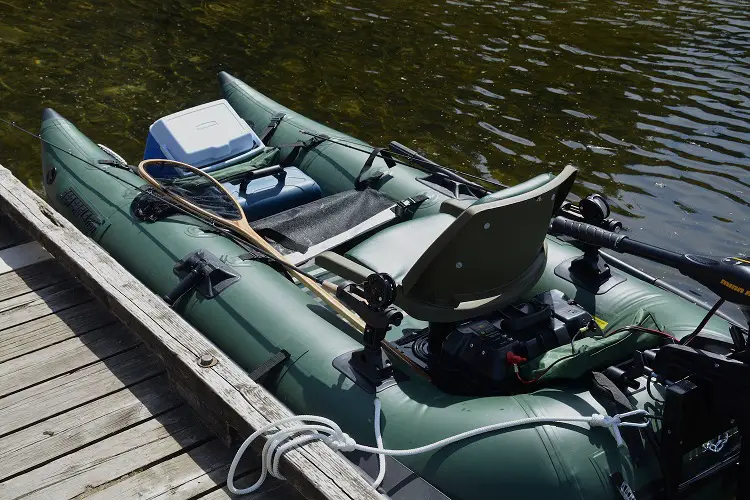
Frameless pontoon boats are every bit as comfortable as their framed counterparts. There are some added benefits of frameless models as well.
Maximum load carrying capability is greater than that of framed models. Gear-heavy trips are better accommodated by frameless boats. And both gas and electric motors are often approved for these boats.
Frameless pontoon boats are also very stable. The ability to stand in a boat while fly casting adds distance to your casting range, and it also lets you stretch your legs. Some models have rigid floors, which makes for an excellent standing surface.
You’ll often find these designs are rated for moving water, even up to class 2 rivers are often fair game! Frameless pontoon boats can open access to significant areas that were not accessible previously.
FLY FISHING RAFTS
Rafts are the big-boys in the world of inflatables. Fishing rafts can be the answer if you are looking to fish those deep whitewater gorges and mid-river runs.
Or maybe you are a guide who wants to provide a safe and fun experience to your sports. You can find our top picks for best whitewater fishing rafts here.
With all the options out there, fishing rafts get the stamp of approval from the safety department. Rafts are incredibly difficult to sink. Even if they are swamped, suffer a puncture, or flip over, rafts stay afloat.
If you want to fish rivers, there is no getting around the fact that the right raft can make an excellent whitewater boat.
Fishing rafts provide access to areas that cannot be accessed by other boats, or even by foot. A fishing raft allows you to tackle rough river conditions that would destroy other boats. A good raft can prove indispensable in these locations.
Whitewater fishing rafts also displace very little water and sit very high as a result. That characteristic allows rafts to float right through shallows and rocky water that other watercraft, like drift boats, cannot pass.
HOW DO RAFT FRAMES WORK?
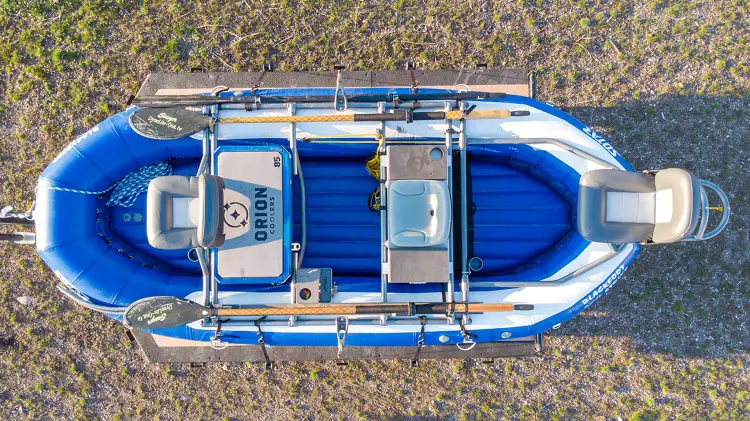
Raft frame dimensions vary widely, and are made to fit a variety of rafts. Some designs are adjustable to allow for modifications, and some have fixed dimensions that cannot be adjusted.
Raft makers have integrated helpful fishing accessories like anchor systems, supportive seats, casting floors, leaning bars and leg braces into their frame designs.
The fishing frame goes hand and hand with the raft it is designed for. Buyers are able to customize frames to fit their rafts and to provide for their exact needs.
Whether you need a simple raft frame with little more than a rowers seat, or if you want to add extra seats, lean bars, and anchor lines, the sky is the limit.
Fishing frames are usually held together with cotter pins or U-bolts which makes assembly a snap. And when your needs for storage and accessories change, it makes for easy adjustment. NRS frames are one that is very well known for their modular ability.
Raft frames are made from aluminum tubing to provide the lightest and strongest frame possible. The NRS frame comes highly recommended among river guides, and is manufactured to fit a wide variety of rafts.
The ability to add or take away seats, floors, anchor systems, and lean bars is a feature many enjoy. The seat positions can be adjusted to provide a better fitting rowing compartment for guides, and braces can be added or removed when gear requirements change.
The wide selection of modular accessories make the NRS frames very versatile and comfortable. Customization is almost entirely unrestricted.
WHAT SIZE RAFT DO I NEED?
The size of the raft you will need is going to depend on how many people you intend to have in the boat. The amount of gear you need to carry will also be a consideration.
Removable seats can provide for additional gear storage if your frame allows. As is the case with other inflatables, rafts are manufactured in all price points.
Cheap set ups can be done, but they may not last, or carry a warranty for very long. If you are fishing around whitewater, bargain rafts are not a gamble worth taking.
Guides, raft owners and end users tend to find a sweet spot in the 12-14 foot range and most manufacturers say their 13 foot models are their most popular boats. Many companies produce their top tier and outfitter grade models in 13 and 14 feet.
The 13-14 foot raft is large enough to comfortably fish two or three people. This arrangement places one in front of the rower and one behind. But remember, a 14 foot raft will sit slightly deeper than a 13 footer.
The raft in 13 feet may then have the edge when the water gets shallow and rocky. But in less technical whitewater, where more gear carrying capacity is needed, a larger raft will shine.
The 13 foot raft will also have the edge in trailering the boat. It’s amazing that an extra foot of length can make moving a raft that much more difficult. It is possible to avoid the trailer and haul a 13 foot boat on a truck.
But that is contingent on the truck as well as the frame on the raft. A trailer may be needed depending on your particular situation. Check out our recommended gear section for our top whitewater fishing raft recommendations.
What Is A Float Tube?
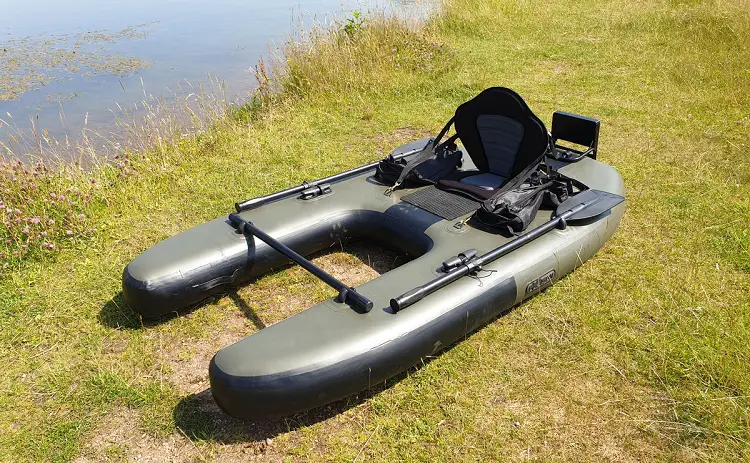
Float tubes are not a new idea, as they have been around for a long time in one form or another.
Initial designs sprang up as nothing more than an inner tube with a colorful nylon covering. Modern float tubes have come a long way since then, and these original round boats are becoming harder and harder to find.
You can read more about modern designs and our top picks for best float tubes here, but you might get the surprise of seeing the original round tube design on the water someday.
The Caddis High Sierra II is an example of a round-tube design. The original inner tube designs were quite popular and effective in their day. But the availability of more accessorized and inexpensive models have somewhat displaced the popularity of original designs.
If you were trying to get into a round tube, you would quickly find one noticeable downside: how difficult it is to get in and out of the circular design with fins on you feet. And it is all but impossible to get fins on after being seated in the tube.
The round tube designs featured a nylon sling-style seat. Certain accessories are essential in all float tubes. Waders will be necessary if you plan on staying warm and dry.
Flippers are also needed to propel yourself around. But the most crucial element will be patience. Flipper-driven float tubes are anything but fast.
MODERN FLOAT TUBE DESIGNS
High-ride seating combined with good back support turn a float tube into a floating lazy-boy.
Newer float tube designs have sought to enhance comfort with little sacrifice of portability. Fortunately many designers have incorporated D-ring connectors for connecting backpack straps.
Truly, the enjoyment factor is remarkable. Rigid foam seating makes for a higher ride and easier casting, but the bulkiness of the foam seat hinders the ability to be placed in a pack for long hikes.
While the comfort level rises so does the price tag, but not significantly so. Fortunately very comfortable models with excellent features are available for around $200.
Modern float tube designs nearly all incorporate zippered storage compartments on both sides. Some are larger than others but most provide ample room for tackle and snacks. Check out more great float tube designs and our top picks for best float tubes here.
What Is A U-Boat?
The U-boat leaves leaves an opening at the front of the ‘U’-shaped boat, and makes sitting down just as easy as sitting in a chair. The seat in a U-boat is usually a flat nylon sling. It definitely works but it’s not exactly the pinnacle of long term comfort.
The sling-style seat also places the angler in the water from the waist down. While that low center of gravity produces a substantially stable platform, it also makes long casts more difficult, and movement very slow.
Water temperature also has a greater effect on body temperature with the lower seat. The U-boat design does have its benefits. One of the benefits is cost.
U-boats are very inexpensive. Another asset is the ability to store and fold up the unit in small spaces.
If you want to hike to a back country fishing hole, they fit in a mid-sized hiking pack. Those of us looking to shed the demands of civilization can appreciate this feature.
References:


